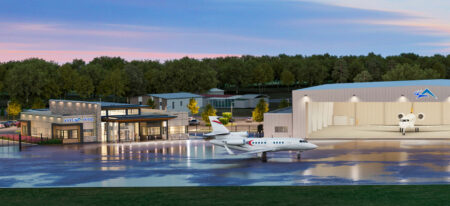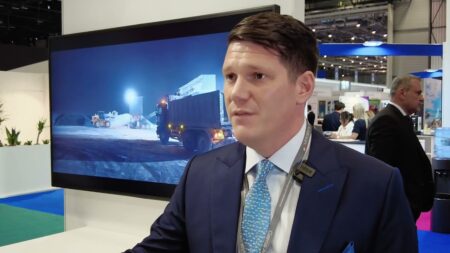The business aviation sector has long been committed to reducing it’s carbon footprint, and sustainable aviation fuel represents a significant breakthrough the industry’s efforts. However, the transition to biofuels is complex, requiring advancements in technology, infrastructure, and regulatory frameworks.
Sustainable aviation fuel (SAF) is produced from a variety of renewable sources. “The production of SAF starts with one of five main families of raw materials: oils and fats, sugar and grain, municipal solid waste, wood and agricultural residue, or renewable energy and carbon,” explains Sven Rieve, Air bp’s sustainability manager. Each feedstock undergoes a specific production process, which relays on approval from fuel standard bodies before it can be commercial deployed. Air bp’s SAF supply chain uses a blend of renewable feedstocks, primarily waste oils and residues that meet stringent sustainability criteria.
“SAF supplied by Air bp uses a blend of renewable feedstocks on a mass balance basis,” says Rieve.
Fellow supplier Neste derives its SAF from used cooking oil and animal fat waste, both of which are 100% renewable. “Neste’s SAF is made from 100% renewable waste and residue raw materials that are sustainably sourced,” says Neste. This approach allows for a significant reduction in greenhouse gas (GHG) emissions of up to 80% over the fuel’s life cycle compared to conventional jet fuel, according to the company.
Neste has developed a robust system to ensure that the renewable products and raw materials used in production meet stringent sustainability criteria. “We carefully select suppliers and only accept renewable raw materials from those that are able to meet strict criteria for sustainability,” adds a Neste spokesperson.
Limited feedstocks
The hydrotreated esters and fatty acids (HEFA) pathway dominates SAF production, driven by its lower capital costs and readily available feedstocks.
“Most of the SAF supplied today in the market is derived using the hydrotreated esters and fatty acids pathway,” says Rieve. This pathway processes feedstocks through standard hydrocracker units after pre-treatment.
HEFA is produced from tallow, used cooking oil, or other waste oils. “These feedstocks are in limited supply and the scale up of SAF demand is increasing feedstock prices. New feedstocks and production pathways are needed to cost-effectively scale up SAF production volume,” says Kennedy Ricci, president of aviation sustainability company 4AIR. “These feedstocks are in limited supply, and the scale-up of SAF demand is increasing feedstock prices,” he says.
“New production pathways, such as alcohol-to-jet and power-to-liquid, are essential for cost-effectively scaling up SAF production volume,” he adds.
Neste has set ambitious targets to reduce emissions within its production processes. By 2030, the company aims to reduce its production emissions by 50% compared to 2019 levels and achieve carbon-neutral production by 2035. These targets are part of a broader strategy encompassing short, medium, and long-term measures.
“Neste’s pathway towards carbon-neutral production includes continuous energy efficiency improvements and scaling up new technologies like renewable hydrogen,” says Neste.
“We expect to see the amount of SAF produced from other sources increasing beyond 2030,” says Rieve.
These emerging pathways will require time to achieve technical and commercial maturity but are crucial for feedstock diversification to meet long-term SAF goals.
While HEFA synthetic paraffinic kerosene (SPK) is the only commercial pathway used at scale, its feedstocks are limited.
Rieve highlights the need for rapid commercial-scale mobilization of sustainable feedstocks, including high-energy crops like algae, Camelina, penny-cress, tallow tree, and carinata. “We promote the use of cover crops as a feedstock when they do not require additional land demand,” he says.
Most production pathways start at a very small scale, gradually increasing to full commercial production. This incremental scaling requires significant investment, and both the US and EU have set up investment or loan incentives to support companies. “The US and EU’s investment and loan incentives help companies get over part of this significant hurdle to market,” says Ricci.
Ensuring SAF is sustainable
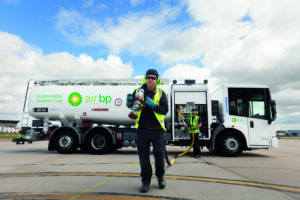
Certification is fundamental to ensuring that SAF is truly sustainable and fully traceable.
“ICAO, the US, and the EU have all laid out criteria through their respective programs to ensure that SAF is sustainable and approved under various certification schemes and third-party auditors to verify fuel under their programs. These criteria ensure that SAF only comes from sustainable feedstocks and does not compete with food or land that could be used for food production, nor result in direct or indirect land-use change.
“In essence, you can’t cut down a rainforest or use other non-sustainable sources such as palm oil for SAF,” says Ricci.
Currently, the Roundtable on Sustainable Biomaterials (RSB) and the International Sustainability and Carbon Certification (ISCC) are the two major certification schemes for SAF.
“It is important that all SAF has these sustainability certifications, which include the actual amount of emissions reduced from a particular SAF used,” adds Ricci. Without proper documentation, SAF cannot be claimed towards regulatory programs or voluntary emissions reductions.
Regulatory authorities and policy makers are playing a vital role in expanding SAF supply, reducing costs, and enhancing sustainability.
“Effective SAF-specific policies and programs should be stable over time, stackable with other incentives, technology neutral, and operate in alignment with greenhouse gas emission reduction targets,” says Ricci.
A standardized methodology for calculating life cycle emissions is crucial for bolstering confidence in SAF’s environmental impact. “Understanding the nuances and variation of different sustainability and GHG emissions saving criteria is important,” Ricci says. This alignment would facilitate industry and government cooperation, enhancing SAF’s credibility and demand.
Challenges with blending
Blending SAF with conventional jet fuel presents technical challenges, primarily due to the lack of aromatics in synthetically produced SAF.
Aromatics are unsaturated hydrocarbons that cause fuel system seals to swell, preventing leaks. “Out of caution, a maximum blend of 50% was set for SAF with Jet A for it to qualify as jet fuel,” explains Ricci.
Commercially, blends of 30-38% are typical due to the complexity of achieving higher quality standards. “Above this level, you must care about the quality of jet fuel used for blending to reach certification, so it is more economical to target these lower blends,” says Ricci.
Future SAF that include aromatics or can be blended with synthetic aromatics could potentially be certified at 100%.
Scaling up SAF
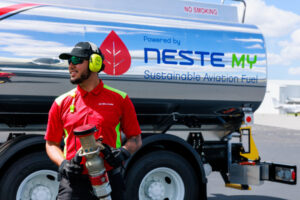
To meet growing demand, companies active across the supply chain will likely capture value and manage demand curves globally.
“bp is well positioned across the value chain and around the world to play a key role in scaling SAF,” says Rieve, highlighting investments the company has made in refineries and facilities in Lingen, Germany, and Castellon, Spain.
Building a SAF production plant is a complex and time-consuming process, often taking up to seven years. “Even before this time, there are many steps, assessments, and studies conducted to help ensure the sustainability and scalability of a certain production method,” explains Ricci. These steps include life cycle assessments, techno-economic analysis, policy reviews, and extensive engineering and design.
In 2022, bp’s Lingen refinery began producing SAF from used cooking oil, marking Germany’s first industrial production facility using co-processing to produce SAF from waste and residues. This process integrates used cooking oil with crude oil in existing facilities, resulting in SAF as one of the end products. “Thanks to co-processing bp can continue to operate the existing plant and also make a direct contribution to decarbonizing fuels on a lifecycle basis,” Rieve says.
Similarly, bp’s Castellon refinery in Spain announced its first sale of ISCC EU SAF in March 2023, with LATAM Airlines becoming the first customer. This milestone underlined the role of co-processing using existing refineries to meet SAF demand.
Neste’s commitment to scaling SAF production is evident in their current and planned capabilities. As of now, Neste’s global SAF production capability stands at 1 million tons per annum, with the Singapore refinery being the world’s largest SAF production facility post-expansion in 2023. By 2024, Neste aims to increase this capacity to 1.5 million metric tons, with further investments boosting it to 2.2 million tons by 2026.
The environmental impact of using Neste’s SAF is profound, with GHG emissions reduced by up to 80% over the fuel’s life cycle. Neste employs established life cycle assessment methodologies such as CORSIA to calculate these reductions. “Neste is exploring opportunities to reduce these emissions further, for example by smarter logistics or using green hydrogen in the production process,” adds the Neste spokesperson.
To scale SAF production effectively, policy support is crucial. This support creates demand certainty, attracting investment into new production capacity and encouraging airlines to adopt SAF.
Knowledge is power
Raising awareness and knowledge about SAF among the aviation industry, regulators, businesses, and individual travelers is essential.
“Every stakeholder has the responsibility to act on their carbon emissions, and SAF provides them a means to do so today,” says the Neste spokesperson.
Despite the promising developments, SAF still costs more to produce than fossil jet fuel, necessitating regulatory support to drive market adoption.
“To ensure the right investment we need to see regulation to force them into the market,” Rieve says. He cites Europe’s recent mandates as positive examples but calls for similar actions from other countries like the USA and Australia.
Rieve also believes that the use of sustainable feedstocks that do not demand additional land and support sustainable farming practices are paramount.
Barriers
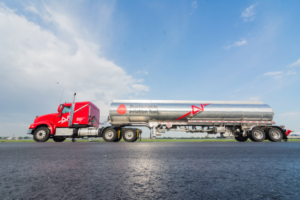
Several barriers hinder the widespread adoption of SAF, including high costs, feedstock availability, and long time horizons for establishing refineries.
“SAF is still significantly more expensive than Jet A, and while operators are seeking sustainable alternatives, the cost of the fuel remains a critical driver,” says Ricci.
There can also be logistical challenges in transporting SAF. “In order to reduce how much fuel needs to be moved around, it is best to wait to blend the SAF with fossil Jet A until you reach a final distribution point,” says Ricci.
“If you blend SAF at 33% right at the production source, you will have to transport three times as much fuel to a fuel terminal compared to if you can wait to blend the fuel at or near the terminal and only transport the neat SAF.
“At a time when SAF production is limited and SAF is being shipped around the world to final markets, this can have a relatively important impact.
“Transporting neat SAF requires some different infrastructure changes and you cannot always use existing pipeline networks. In addition, moving SAF far from its production source raises not only its cost but also its carbon intensity,” Ricci says.
The path to decarbonizing aviation through SAF is complex and the industry’s success hinges on a collective effort to scale SAF production and create a sustainable future for aviation.



